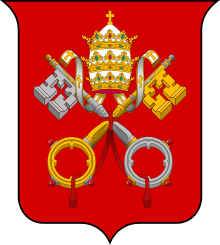Sistine Chapel ceiling

The Sistine Chapel ceiling, painted by Michelangelo between 1508 and 1512, is a cornerstone work of High Renaissance art.
The ceiling is that of the Sistine Chapel, the large papal chapel built within the Vatican between 1477 and 1480 by Pope Sixtus IV, for whom the chapel is named. It was painted at the commission of Pope Julius II. The chapel is the location for papal conclaves and many important services.[1]
The ceiling's various painted elements form part of a larger scheme of decoration within the Chapel, which includes the large fresco The Last Judgment on the sanctuary wall, also by Michelangelo, wall paintings by several leading painters of the late 15th century including Sandro Botticelli, Domenico Ghirlandaio and Pietro Perugino, and a set of large tapestries by Raphael, the whole illustrating much of the doctrine of the Catholic Church.[2][3]
Central to the ceiling decoration are nine scenes from the Book of Genesis of which The Creation of Adam is the best known, having an iconic standing equalled only by Leonardo da Vinci's Mona Lisa, the hands of God and Adam being reproduced in countless imitations. The complex design includes several sets of individual figures, both clothed and nude, which allowed Michelangelo to fully demonstrate his skill in creating a huge variety of poses for the human figure and which have provided an enormously influential pattern book of models for other artists ever since.
Context and history

Pope Julius II was a "warrior pope" who in his papacy undertook an aggressive campaign for political control, to unite and empower Italy under the leadership of the Church. He invested in symbolism to display his temporal power, such as his procession, in the Classical manner, through a triumphal arch in a chariot after one of his many military victories. It was Julius who began the rebuilding of St. Peter's Basilica in 1506, as the most potent symbol of the source of papal power.[4]
In the same year 1506, Pope Julius conceived a program to paint the ceiling of the Sistine Chapel.[5] The walls of the chapel had been decorated twenty years earlier. The lowest of three levels is painted to resemble draped hangings and was (and sometimes still is) hung on special occasions with the set of tapestries designed by Raphael. The middle level contains a complex scheme of frescoes illustrating the Life of Christ on the right side and the Life of Moses on the left side. It was carried out by some of the most renowned Renaissance painters: Botticelli, Ghirlandaio, Perugino, Pinturicchio, Signorelli and Cosimo Rosselli.[6] The upper level of the walls contains the windows, between which are painted pairs of illusionistic niches with representations of the first thirty-two popes.[7] A draft by Matteo d'Amelia indicates that the ceiling was painted blue like that of the Arena Chapel and decorated with gold stars, possibly representing the zodiacal constellations. It is probable that, because the chapel was the site of regular meetings and Masses of an elite body of officials known as the Papal Chapel who would observe the decorations and interpret their theological and temporal significance, it was Pope Julius' intention and expectation that the iconography of the ceiling was to be read with many layers of meaning.[8]
Michelangelo, who was not primarily a painter but a sculptor, was reluctant to take on the work. Also, he was occupied with a very large sculptural commission for the pope's own tomb. The pope was adamant, leaving Michelangelo no choice but to accept.[9] But a war with the French broke out, diverting the attention of the pope, and Michelangelo fled from Rome to continue sculpting. The tomb sculptures, however, were never to be finished because in 1508 the pope returned to Rome victorious and summoned Michelangelo to begin work on the ceiling. The contract was signed on 10 May 1508.[5]
The scheme proposed by the pope was for twelve large figures of the Apostles to occupy the pendentives.[10][11] However, Michelangelo negotiated for a grander, much more complex scheme and was finally permitted, in his own words, "to do as I liked".[12] His scheme for the ceiling eventually comprised some three hundred figures and took four years to execute, being completed and shown to the public on All Saints Day in 1512 after a preliminary showing and papal Mass on August 14, 1511.[5][9] It is unknown and is the subject of much speculation among art historians as to whether Michelangelo was really able to "do as he liked".[11] It has been suggested that the Augustinian friar and cardinal, Giles of Viterbo, was a consultant for the theological aspect of the work.[13] Many writers consider that Michelangelo had the intellect, the Biblical knowledge, and the powers of invention to have devised the scheme himself. This is supported by Ascanio Condivi's statement that Michelangelo read and reread the Old Testament while he was painting the ceiling, drawing his inspiration from the words of the scripture, rather than from the established traditions of sacral art.[14] There was a total of 343 figures painted on the ceiling.
Method
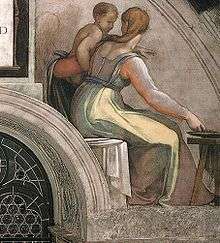
To reach the chapel's ceiling, Michelangelo designed his own scaffold, a flat wooden platform on brackets built out from holes in the wall near the top of the windows, rather than being built up from the floor. Mancinelli speculates that this was in order to cut the cost of timber.[15] According to Michelangelo's pupil and biographer Ascanio Condivi, the brackets and frame that supported the steps and flooring were all put in place at the beginning of the work and a lightweight screen, possibly cloth, was suspended beneath them to catch plaster drips, dust, and splashes of paint.[16] Only half the building was scaffolded at a time and the platform was moved as the painting was done in stages.[15] The areas of the wall covered by the scaffolding still appear as unpainted areas across the bottom of the lunettes. The holes were re-used to hold scaffolding in the latest restoration.
Contrary to popular belief, he painted in a standing position, not lying on his back. According to Vasari, "The work was carried out in extremely uncomfortable conditions, from his having to work with his head tilted upwards".[9] Michelangelo described his physical discomfort in a humorous sonnet accompanied by a little sketch.
The painting technique employed was fresco, in which the paint is applied to damp plaster. Michelangelo had been an apprentice in the workshop of Domenico Ghirlandaio, one of the most competent and prolific of Florentine fresco painters, at the time that the latter was employed on a fresco cycle at Santa Maria Novella and whose work was represented on the walls of the Sistine Chapel.[17] At the outset, the plaster, intonaco, began to grow mold because it was too wet. Michelangelo had to remove it and start again. He then tried a new formula created by one of his assistants, Jacopo l'Indaco, which resisted mold and entered the Italian building tradition.[16]
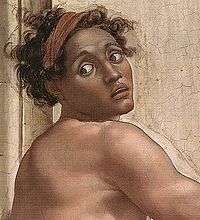
Because he was painting fresco, the plaster was laid in a new section every day, called a giornata. At the beginning of each session, the edges would be scraped away and a new area laid down.[15] The edges between giornate remain slightly visible; thus, they give a good idea of how the work progressed. It was customary for fresco painters to use a full-sized detailed drawing, a cartoon, to transfer a design onto a plaster surface—many frescoes show little holes made with a stiletto, outlining the figures. Here Michelangelo broke with convention; once confident the intonaco had been well applied, he drew directly onto the ceiling. His energetic sweeping outlines can be seen scraped into some of the surfaces,[nb 1] while on others a grid is evident, indicating that he enlarged directly onto the ceiling from a small drawing.
Michelangelo painted onto the damp plaster using a wash technique to apply broad areas of colour, then as the surface became drier, he revisited these areas with a more linear approach, adding shade and detail with a variety of brushes. For some textured surfaces, such as facial hair and woodgrain, he used a broad brush with bristles as sparse as a comb. He employed all the finest workshop methods and best innovations, combining them with a diversity of brushwork and breadth of skill far exceeding that of the meticulous Ghirlandaio.[nb 2]
The work commenced at the end of the building furthest from the altar, with the latest of the narrative scenes, and progressed towards the altar with the scenes of the Creation.[13] The first three scenes, from the story of Noah, contain a much larger number of small figures than the later panels. This is partly because of the subject matter, which deals with the fate of Humanity, but also because all the figures at that end of the ceiling, including the prophets and Ignudi, are smaller than in the central section.[18] As the scale got larger, Michelangelo's style became broader, the final narrative scene of God in the act of Creation was painted in a single day.[19]
The bright colours and broad, cleanly defined outlines make each subject easily visible from the floor. Despite the height of the ceiling, the proportions of the Creation of Adam are such that when standing beneath it, "it appears as if the viewer could simply raise a finger and meet those of God and Adam". Vasari tells us that the ceiling is "unfinished", that its unveiling occurred before it could be reworked with gold leaf and vivid blue lapis lazuli as was customary with frescoes and in order to better link the ceiling with the walls below it which were highlighted with a great deal of gold. But this never took place, in part because Michelangelo was reluctant to set up the scaffolding again, and probably also because the gold and particularly the intense blue would have distracted from his painterly conception.[9]
Some areas were, in fact, decorated with gold: the shields between the Ignudi and the columns between the Prophets and Sibyls. It seems very likely that the gilding of the shields was part of Michelangelo's original scheme, since they are painted to resemble a certain type of parade shield, a number of which still exist and are decorated in a similar style with gold.
Section reference.[9][15][16][20]
Michelangelo wrote a poem describing the arduous conditions under which he worked[21]

- I've grown a goitre by dwelling in this den–
- As cats from stagnant streams in Lombardy,
- Or in what other land they hap to be–
- Which drives the belly close beneath the chin:
- My beard turns up to heaven; my nape falls in,
- Fixed on my spine: my breast-bone visibly
- Grows like a harp: a rich embroidery
- Bedews my face from brush-drops thick and thin.
- My loins into my paunch like levers grind:
- My buttock like a crupper bears my weight;
- My feet unguided wander to and fro;
- In front my skin grows loose and long; behind,
- By bending it becomes more taut and strait;
- Crosswise I strain me like a Syrian bow:
- Whence false and quaint, I know,
- Must be the fruit of squinting brain and eye;
- For ill can aim the gun that bends awry.
- Come then, Giovanni, try
- To succour my dead pictures and my fame;
- Since foul I fare and painting is my shame.
Content
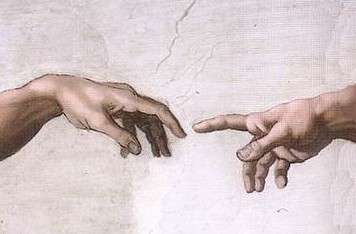
The overt subject matter of the ceiling is the doctrine of humanity's need for Salvation as offered by God through Jesus. It is a visual metaphor of Humankind's need for a covenant with God. The Old Covenant of the Children of Israel through Moses and the New Covenant through Christ had already been represented around the walls of the chapel.[2] Some experts, including Benjamin Blech and Vatican art historian Enrico Bruschini, have also noted less overt subject matter, which they describe as being "concealed" and "forbidden."[22][23]
The main components of the design are nine scenes from the Book of Genesis, of which five smaller ones are each framed and supported by four naked youths or Ignudi. At either end, and beneath the scenes are the figures of twelve men and women who prophesied the birth of Jesus. On the crescent-shaped areas, or lunettes, above each of the chapel's windows are tablets listing the Ancestors of Christ and accompanying figures. Above them, in the triangular spandrels, a further eight groups of figures are shown, but these have not been identified with specific Biblical characters. The scheme is completed by four large corner pendentives, each illustrating a dramatic Biblical story.[18]
The narrative elements of the ceiling illustrate that God made the World as a perfect creation and put humanity into it, that humanity fell into disgrace and was punished by death and by separation from God. Humanity then sank further into sin and disgrace, and was punished by the Great Flood. Through a lineage of Ancestors – from Abraham to Joseph – God sent the saviour of humanity, Christ Jesus. The coming of the Saviour was prophesied by Prophets of Israel and Sibyls of the Classical world. The various components of the ceiling are linked to this Christian doctrine.[18] Traditionally, the Old Testament was perceived as a prefiguring of the New Testament. Many incidents and characters of the Old Testament were commonly understood as having a direct symbolic link to some particular aspect of the life of Jesus or to an important element of Christian doctrine or to a sacrament such as Baptism or the Eucharist. Jonah, for example, was readily recognisable by his attribute of the large fish and was commonly seen to symbolise Jesus' death and resurrection.[3]
While much of the symbolism of the ceiling dates from the early church, the ceiling also has elements that express the specifically Renaissance thinking that sought to reconcile Christian theology with the philosophy of Renaissance Humanism.[24] During the 15th century in Italy, and in Florence in particular, there was a strong interest in Classical literature and the philosophies of Plato, Socrates and other Classical writers. Michelangelo, as a young man, had spent time at the Humanist academy established by the Medici family in Florence. He was familiar with early Humanist-inspired sculptural works such as Donatello's bronze David and had himself responded by carving the enormous nude marble David, which was placed in the piazza near the Palazzo Vecchio, the home of Florence's council.[25] The Humanist vision of humanity was one in which people responded to other people, to social responsibility, and to God in a direct way, not through intermediaries, such as the Church.[26] This conflicted with the Church's emphasis. While the Church emphasized humanity as essentially sinful and flawed, Humanism emphasized humanity as potentially noble and beautiful.[nb 3] These two views were not necessarily irreconcilable to the Church, but only through a recognition that the unique way to achieve this "elevation of spirit, mind and body" was through the Church as the agent of God. To be outside the Church was to be beyond Salvation. In the ceiling of the Sistine Chapel, Michelangelo presented both Catholic and Humanist elements in a way that does not appear visually conflicting. The inclusion of "non-biblical" figures such as the Sibyls or Ignudi is consistent with the rationalising of Humanist and Christian thought of the Renaissance. This rationalisation was to become a target of the Counter Reformation.
The iconography of the ceiling has had various interpretations in the past, some elements of which have been contradicted by modern scholarship.[nb 4] Others, such as the identity of the figures in the lunettes and spandrels, continue to defy interpretation.[27] Modern scholars have sought, as yet unsuccessfully, to determine a written source of the theological program of the ceiling and have questioned whether or not it was entirely devised by the artist himself, who was both an avid reader of the Bible and a genius.[28] Also of interest to some modern scholars is the question of how Michelangelo's own spiritual and psychological state is reflected in the iconography and the artistic expression of the ceiling. One such speculation is that Michelangelo was tormented by conflict between homosexual desires and passionate Christian beliefs.[nb 5]
Michelangelo's scheme realised
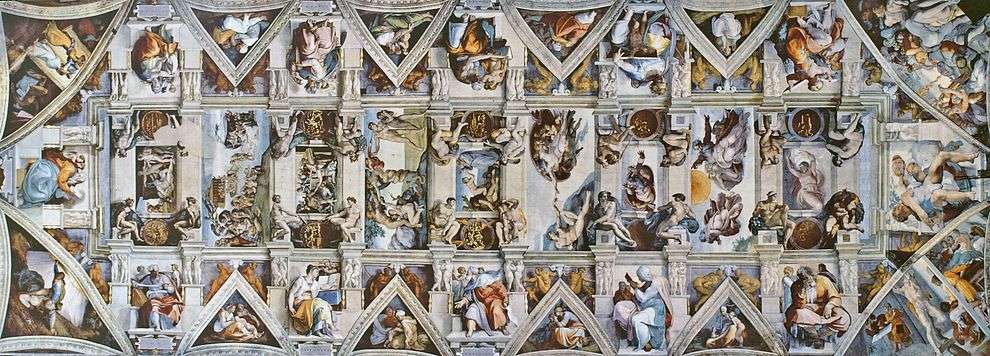
Architectural scheme
Real
The Sistine Chapel is 40.9 metres long and 14 metres wide. The ceiling rises to 13.4 metres above the main floor of the chapel. The vault is of quite a complex design and it is unlikely that it was originally intended to have such elaborate decoration. Pier Matteo d'Amelia provided a plan for its decoration with the architectural elements picked out and the ceiling painted blue and dotted with gold stars, similar to that of the Arena Chapel decorated by Giotto at Padua.[29]
The chapel walls have three horizontal tiers with six windows in the upper tier down each side. There were also two windows at each end, but these have been closed up above the altar when Michelangelo's Last Judgement was painted, obliterating two lunettes. Between the windows are large pendentives which support the vault. Between the pendentives are triangularly shaped arches or spandrels cut into the vault above each window. Above the height of the pendentives, the ceiling slopes gently without much deviation from the horizontal.[29] This is the real architecture. Michelangelo has elaborated it with illusionary or fictive architecture.
Illusionary
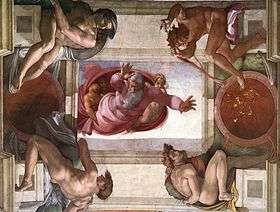
The first element in the scheme of painted architecture is a definition of the real architectural elements by accentuating the lines where spandrels and pendentives intersect with the curving vault. Michelangelo painted these as decorative courses that look like sculpted stone moldings.[nb 6] These have two repeating motifs, a formula common in Classical architecture.[nb 7] Here, one motif is the acorn, the symbol of the family of both Pope Sixtus IV, who built the chapel, and Pope Julius II, who commissioned Michelangelo's work.[nb 8][30] The other motif is the scallop shell, one of the symbols of the Madonna, to whose assumption the chapel was dedicated in 1483.[nb 9][31] The crown of the wall then rises above the spandrels, to a strongly projecting painted cornice that runs right around the ceiling, separating the pictorial areas of the biblical scenes from the figures of Prophets, Sibyls, and Ancestors, who literally and figuratively support the narratives. Ten broad painted crossribs of travertine cross the ceiling and divide it into alternately wide and narrow pictorial spaces, a grid that gives all the figures their defined place.[32]
A great number of small figures are integrated with the painted architecture, their purpose apparently purely decorative. These include two faux marble putti below the cornice on each rib, each one a male and female pair; stone rams-heads are placed at the apex of each spandrel; copper-skinned nude figures in varying poses, hiding in the shadows, propped between the spandrels and the ribs like animated bookends; and more putti, both clothed and unclothed strike a variety of poses as they support the nameplates of the Prophets and Sibyls.[33] Above the cornice and to either side of the smaller scenes are an array of round shields, or medaillons. They are framed by a total of twenty more figures, the so-called Ignudi, which are not part of the architecture but sit on inlaid plinths, their feet planted convincingly on the fictive cornice. Pictorially, the Ignudi appear to occupy a space between the narrative spaces and the space of the chapel itself. (see below)
Pictorial scheme
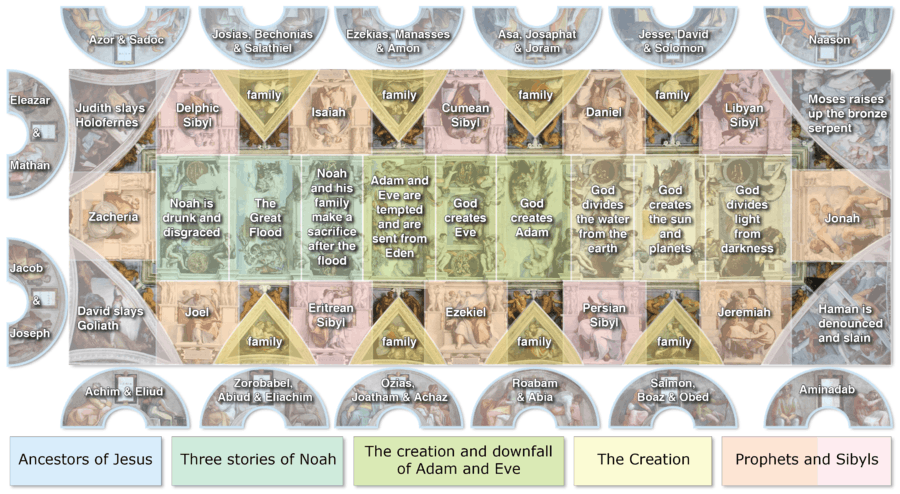
Nine scenes from the Book of Genesis
Along the central section of the ceiling, Michelangelo depicted nine scenes from the Book of Genesis, the first book of the Bible. The pictures are organized into three groups of three alternating large and small panels.[34]
The first group shows God creating the Heavens and the Earth. The second group shows God creating the first man and woman, Adam and Eve, and their disobedience of God and consequent expulsion from the Garden of Eden where they have lived and where they walked with God. The third group of three pictures shows the plight of Humanity and in particular the family of Noah.
The pictures are not in strictly chronological order. If they are perceived as three groups, then the pictures in each of the three units inform upon each other, in the same way as was usual in Medieval paintings and stained glass.[35] The three sections of Creation, Downfall, and Fate of Humanity appear in reverse order, when read from the entrance of the chapel. However, each individual scene is painted to be viewed when looking toward the altar.[34] This is not easily apparent when viewing a reproduced image of the ceiling but becomes clear when the viewer looks upward at the vault. Paoletti and Radke suggest that this reversed progression symbolises a return to a state of grace.[34] However, the three sections are generally described in the order of Biblical chronology.
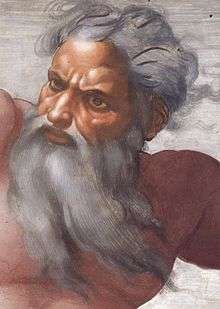
The scenes, from the altar toward the main door, are ordered as follows:
- The Separation of Light and Darkness
- The Creation of the Sun, Moon and Earth
- The Separation of Land and Water
- The Creation of Adam
- The Creation of Eve
- The Temptation and Expulsion
- The Sacrifice of Noah
- The Great Flood
- The Drunkenness of Noah
Creation
The three Creation pictures show scenes from the first chapter of Genesis, which relates that God created the Earth and all that is in it in six days, resting on the seventh day. In the first scene, the First Day of Creation, God creates light and separates light from darkness.[Fig 1] Chronologically, the next scene takes place in the third panel, in which, on the Second Day, God divides the waters from the heavens.[Fig 2] In the central panel, the largest of the three, there are two representations of God. On the Third Day, God creates the Earth and makes it sprout plants. On the Fourth Day, God puts the Sun and the Moon in place to govern the night and the day, the time and the seasons of the year.[Fig 3] According to Genesis, on the Fifth Day, God created the birds of the air and fish and creatures of the deep, but we are not shown this. Neither do we see God's creation of the creatures of the earth on the Sixth Day.[5][Src 1]
These three scenes, completed in the third stage of painting, are the most broadly conceived, the most broadly painted and the most dynamic of all the pictures. Of the first scene Vasari says "... Michelangelo depicted God dividing Light from Darkness, showing him in all his majesty as he rests self-sustained with arms outstretched, in a revelation of love and creative power."[9]
Adam and Eve
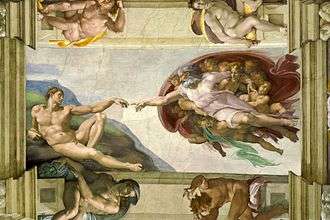
For the central section of the ceiling, Michelangelo has taken four episodes from the story of Adam and Eve as told in the first, second and third chapters of Genesis. In this sequence of three, two of the panels are large and one small.
In the first of the pictures, and one of the most widely recognised images in the history of painting, Michelangelo shows God reaching out to touch Adam, who, in the words of Vasari, is "a figure whose beauty, pose and contours are such that it seems to have been fashioned that very moment by the first and supreme creator rather than by the drawing and brush of a mortal man."[9] From beneath the sheltering arm of God, Eve looks out, a little apprehensively.[18] The "glory" of God, represented by a dark shaded area around him, has the same anatomical geometry as a human brain.
The central scene, of God creating Eve from the side of the sleeping Adam[Fig 4] has been taken in its composition directly from another Creation sequence, the relief panels that surround the door of the Basilica of San Petronio, Bologna by Jacopo della Quercia whose work Michelangelo had studied in his youth.[36][37]
In the final panel of this sequence Michelangelo combines two contrasting scenes into one panel,[Fig 5] that of Adam and Eve taking fruit from the forbidden tree, Eve trustingly taking it from the hand of the Serpent and Adam eagerly picking it for himself; and their banishment from the Garden of Eden, where they have lived in the company of God, to the world outside where they have to fend for themselves and experience death.[5][Src 2]
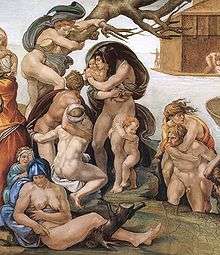
Story of Noah
As with the first sequence of pictures, the three panels concerning Noah, taken from the sixth to ninth chapters of Genesis are thematic rather than chronological. In the first scene is shown the sacrifice of a sheep.[Fig 6] Vasari, in writing about this scene mistakes it for the sacrifices by Cain and Abel, in which Abel's sacrifice was acceptable to God and Cain's was not. What this image almost certainly depicts is the sacrifice made by the family of Noah, after their safe deliverance from the Great Flood which destroyed the rest of Humankind.
The central, larger, scene shows the Great Flood.[Fig 7] The Ark in which Noah's family escaped floats at the rear of the picture while the rest of humanity tries frantically to scramble to some point of safety. This picture, which has a large number of figures, conforms the most closely to the format of the paintings that had been done around the walls.
The final scene is the story of Noah's drunkenness.[Fig 8] After the Flood, Noah tills the soil and grows vines. He is shown doing so, in the background of the picture. He becomes drunk and inadvertently exposes himself. His youngest son, Ham, brings his two brothers Shem and Japheth to see the sight but they discreetly cover their father with a cloak. Ham is later cursed by Noah and told that the descendants of Ham's son Canaan will serve Shem and Japheth's descendants forever. Taken together, these three pictures serve to show that Humankind had moved a long way from God's perfect creation. However, it is through Shem and his descendants, the Israelites, that Salvation will come to the world.[Src 3]
Since Michelangelo executed the nine Biblical scenes in reverse chronological order, some analyses of the frescoes of the vault commence with the Drunkenness of Noah. Tolnay's Neoplatonic interpretation sees the story of Noah at the beginning and the act of Creation by God as the conclusion of the process of deificatio and the return from physical to spiritual being.[38]
Shields
Adjacent to the smaller Biblical scenes and supported by the Ignudi are ten circular parade shields, sometimes described as being painted to resemble bronze. Known examples are actually of lacquered and gilt wood.[39] Each is decorated with a picture drawn from the Old Testament or the Book of Maccabees from the Apocrypha.
The subjects are the more gruesome or shameful of Biblical episodes, the only exception seeming to be that of Elijah being swept up to Heaven in a Chariot of Fire, leaving his mantel to fall on Elisha. However, Elijah's role as a prophet was one marked by accusation and warnings to repent, and the purpose of his translation into Heaven was traditionally seen as so that he might stand before God to condemn Israel for its sins.[Src 4] In four of the five most highly finished "medallions" the space is crowded with figures in violent action, similar to Michelangelo's cartoon for the Battle of Cascina.[nb 10]
The application of gold on the shields, in contrast to its absence on the rest of the ceiling, serves to link the ceiling to some extent with the frescoes around the walls. In the latter, gold leaf has been applied lavishly to many details and in some of the frescoes, notably those by Perugino, has been most expertly used not just to detail the robes but to highlight the folds by subtle graduation in the density of golden flecks. It is this technique that Michelangelo has picked up on and carried a step further, inspired also perhaps by the medallions that appear on a Roman triumphal arch in Botticelli's episode from the Life of Moses, showing the Punishment of the Rebels.
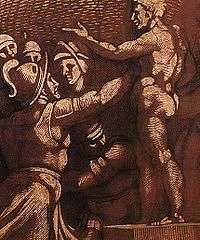

The medallions represent:
- Abraham about to sacrifice his son Isaac
- The Destruction of the Statue of Baal
- The worshippers of Baal being brutally slaughtered.
- Uriah being beaten to death.[Fig 9]
- Nathan the priest condemning King David for murder and adultery.
- King David's traitorous son Absalom caught by his hair in a tree while trying to escape and beheaded by David's troops.
- Joab sneaking up on Abner to murder him
- Joram being hurled from a chariot onto his head.
- Elijah being carried up to Heaven
- On one medallion the subject is either obliterated or incomplete.[Fig 10]
Twelve prophetic figures
On the five pendentives along each side and the two at either end, Michelangelo painted the largest figures on the ceiling: twelve people who prophesied or represented some aspect of the Coming of Christ. Of those twelve, seven were Prophets of Israel and were male. The remaining five were prophets of the Classical World, called Sibyls and were female. The prophet Jonah is placed above the altar and Zechariah at the further end. The other male and female figures alternate down each side, each being identified by an inscription on a painted marble panel supported by a putto.
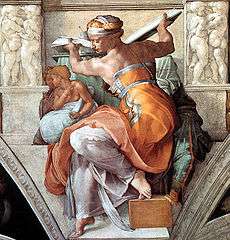
- Jonah (IONAS) – above the altar[Fig 11]
- Jeremiah (HIEREMIAS) [Fig 12]
- Persian Sibyl (PERSICHA)[Fig 13]
- Ezekiel (EZECHIEL)[Fig 14]
- Erythraean Sibyl. (ERITHRAEA)[Fig 15]
- Joel (IOEL)[Fig 16]
- Zechariah (ZACHERIAS) – above the main door of the chapel[Fig 17]
- Delphic Sibyl. (DELPHICA)[Fig 18]
- Isaiah (ESAIAS)[Fig 19]
- Cumaean Sibyl. (CVMAEA)[Fig 20]
- Daniel (DANIEL)[Fig 21]
- Libyan Sibyl (LIBICA)[Fig 22]
Prophets
The seven prophets of Israel chosen for depiction on the ceiling include the four so-called Major Prophets, Isaiah, Jeremiah, Ezekiel and Daniel. Of the remaining twelve possibilities among the Minor Prophets, the three represented are Joel, Zechariah and Jonah. Although the prophets Joel and Zechariah are considered "minor" because of the comparatively small number of pages that their prophecy occupies in the Bible, each one produced prophesies of profound significance.
.jpg)
They are often quoted, Joel for his "Your sons and your daughters shall prophesy, your elderly shall dream dreams and your youth shall see visions".[Src 5] These words are significant for Michelangelo's decorative scheme, where women take their place among men and the youthful Daniel sits across from the brooding Jeremiah with his long white beard.
Zechariah prophesied, "Behold! Your King comes to you, humble and riding on a donkey".[Src 6][41] His place in the chapel is directly above the door through which the Pope is carried in procession on Palm Sunday, the day on which Jesus fulfilled the prophecy by riding into Jerusalem on a donkey and being proclaimed King.[42]
_-_Jonah_and_Jesus.jpg)
Jonah is of symbolic and prophetic significance, which was commonly perceived and had been represented in countless works of art including manuscripts and stained glass windows.[35] Through his reluctance to obey God, he was swallowed by a "mighty fish".[nb 11] He spent three days in its belly and was eventually spewed up on dry land where he went about God's business.[Src 7] Jonah was thus seen as presaging Jesus, who having died by crucifixion, spent part of three days in a tomb and was raised on the third day.[Src 8] So, on the ceiling of the Sistine Chapel, Jonah, with the "great fish" beside him and his eyes turned towards God the Creator,[Fig 11] represents a "portent" of the Passion[43] and Resurrection of Christ.[41] The Jonah figure placed right over the altar activated the Passion motif. "When Perugino's altar painting was removed and ... Last Judgement fresco came to cover the altar wall",[43] after at least twenty five years Michelangelo depicted Christ just below Jonah: not only for his role as precursor of Christ, Christianity and Christocentrism, but also because his powerful torsion of the body, bent backwards from the bust to the eyes and with his forefingers that now point the glorious Jesus to the characters of the ceiling, assumes a function of link between the Old and New Testament.
In Vasari's description of the Prophets and Sibyls he is particularly high in his praise of the portrayal of Isaiah:[Fig 19] "Anyone who studies this figure, copied so faithfully from nature, the true mother of the art of painting, will find a beautifully composed work capable of teaching in full measure all the precepts to be followed by a good painter."[9]
Sibyls
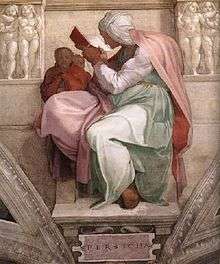
The Sibyls were prophetic women who were resident at shrines or temples throughout the Classical World. The five depicted here are each said to have prophesied the birth of Christ. The Cumaean Sibyl, for example, is quoted by Virgil in his Fourth Eclogue as declaring that "a new progeny of Heaven" would bring about a return of the "Golden Age". This was interpreted as referring to Jesus.[44]
In Christian doctrine, Christ came not just to the Jews but also to the Gentiles. It was understood that, prior to the Birth of Christ, God prepared the world for his coming. To this purpose, God used Jews and Gentiles alike. Jesus would not have been born in Bethlehem (where it had been prophesied that his birth would take place),[Src 9] except for the fact that the pagan Roman Emperor Augustus decreed that there should be a census.[Src 10] Likewise, when Jesus was born, the announcement of his birth was made to rich and to poor, to mighty and to humble, to Jew and to Gentile. The Three Wise Men (the "Magi" of the Bible) who sought out the infant King with precious gifts were pagan foreigners.[Src 11]
In the Church of Rome, where there was an increasing interest in the remains of the city's pagan past, where scholars turned from reading Medieval Church Latin to Classical Latin and the philosophies of the Classical world were studied along with the writings of St Augustine, the presence, in the Sistine Chapel of five pagan prophets is not surprising.[45]
It is not known why Michelangelo selected the five particular Sibyls that were depicted, given that, as with the Minor Prophets, there were ten or twelve possibilities. It is suggested by John O'Malley that the choice was made for a wide geographic coverage, with the Sibyls coming from Africa, Asia, Greece and Ionia.[44]
Vasari says of the Erythraean Sibyl[Fig 15] "Many aspects of this figure are of exceptional loveliness: the expression of her face, her headdress and the arrangement of her draperies: and her arms, which are bared, are as beautiful as the rest." [9]
Pendentives
In each corner of the chapel is a triangular pendentive filling the space between the walls and the arch of the vault and forming the spandrel above the windows nearest the corners. On these curving shapes Michelangelo has painted four scenes from Biblical stories that are associated with the salvation of Israel by four great male and female heroes of the Jews: Moses, Esther, David and Judith.[46]
The first two stories were both seen in Medieval- and Renaissance theology as prefiguring the Crucifixion of Jesus. In the story of the Brazen Serpent, the people of Israel become dissatisfied and grumble at God. As punishment they receive a plague of venonous snakes. God offers the people relief by instructing Moses to make a snake of brass and set it up on a pole, the sight of which gives miraculous healing.[Src 12] Michelangelo chooses a crowded composition, depicting a dramatic mass of suffering men, women, and writhing snakes, separated from redeemed worshipers by the snake before an epiphanic light.[Fig 23]
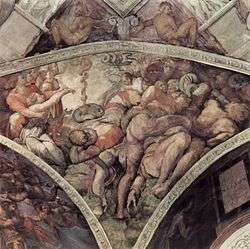
In the Book of Esther it is related that Haman, a public servant, plots to get Esther's husband, the King of Persia, to slay all the Jewish people in his land. The King, who is going over his books during a sleepless night, realises something is amiss. Esther, discovering the plot, denounces Haman, and her husband orders his execution on a scaffold he has built. The King's eunuchs promptly carry this out.[Src 13] Michelangelo shows Haman crucified with Esther looking at him from a doorway, the King giving orders in the background.[Fig 24]
The other two stories, those of David and Judith, were often linked in Renaissance art, particularly by Florentine artists as they demonstrated the overthrow of tyrants, a popular subject in the Republic. In this image, the shepherd boy, David, has brought down the towering Goliath with his sling, but the giant is alive and is trying to rise as David forces his head down to chop it off.[47][Fig 25]
The depiction of Judith and Holofernes has an equally gruesome detail. As Judith loads the enemy's head onto a basket carried by her maid and covers it with a cloth, she looks towards the tent,[47] apparently distracted by the limbs of the decapitated corpse flailing about.[Fig 26]
There are obvious connections in the design of the Slaying of Holofernes and the Slaying of Haman at the opposite end of the chapel. Although in the Holofernes picture the figures are smaller and the space less filled, both have the triangular space divided into two zones by a vertical wall, allowing us to see what is happening on both sides of it. There are actually three scenes in the Haman picture because as well as seeing Haman punished, we see him at the table with Esther and the King and get a view of the King on his bed.[47] Mordechai sits on the steps, making a link between the scenes.[48]
While the Slaying of Goliath is a relatively simple composition with the two protagonists centrally placed and the only other figures being dimly seen observers, the Brazen Serpent picture is crowded with figures and separate incidents as the various individuals who have been attacked by snakes struggle and die or turn toward the icon that will save them. This is the most Mannerist of Michelangelo's earlier compositions at the Sistine Chapel,[47] picking up the theme of human distress begun in the Great Flood scene and carrying it forward into the torment of lost souls in the Last Judgement, which was later painted below.
Ancestors of Christ
Subject
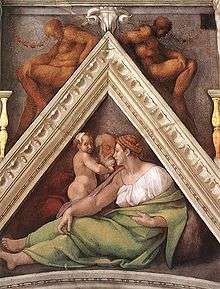
Between the large pendentives that support the vault are windows, six on each side of the chapel. There were two more windows in each end of the chapel, now closed, and those above the High Altar covered by the Last Judgement. Above each window is an arched shape, referred to as a lunette and above eight of the lunettes at the sides of the chapel are triangular spandrels filling the spaces between the side pendentives and the vault, the other eight lunettes each being below one of the corner pendentives.
Michelangelo was commissioned to paint these areas as part of the work on the ceiling. The structures form visual bridges between the walls and the ceiling, and the figures which are painted on them are midway in size (approximately 2 metres high) between the very large prophets and the much smaller figures of Popes which had been painted to either side of each window in the 15th century.[49] Michelangelo chose the Ancestors of Christ as the subject of these images,[50] thus portraying Jesus' physical lineage, while the papal portraits are his spiritual successors, according to Church doctrine.[51] (see gallery)
Centrally placed above each window is a faux marble tablet with a decorative frame. On each is painted the names of the male line by which Jesus, through his Earthly father, Joseph, is descended from Abraham, according to the Gospel of Matthew.[nb 12] However, the genealogy is now incomplete, since the two lunettes of the windows in the Altar wall were destroyed by Michelangelo when he returned to the Sistine Chapel in 1537 to paint The Last Judgment.[52] Only engravings, based on a drawing that has since been lost, remain of them.[Fig 27] The sequence of tablets seems a little erratic as one plaque has four names, most have three or two, and two plaques have only one. Moreover, the progression moves from one side of the building to the other, but not consistently, and the figures the lunettes contain do not coincide closely with the listed names. These figures vaguely suggest various family relationships; most lunettes contain one or more infants, and many depict a man and a woman, often sitting on opposing sides of the painted plaque that separates them. O'Malley describes them as "simply representative figures, almost ciphers".[50]
There is also an indeterminate relationship between the figures in the spandrels and the lunettes beneath them. Because of the constraints of the triangular shape, in each spandrel the figures are seated on the ground. In six of the eight spandrels the compositions resemble traditional depictions of the Flight into Egypt. Of the two remaining, one shows a woman with shears trimming the neck of a garment she is making while her toddler looks on.[Fig 28] The Biblical woman who is recorded as making a new garment for her child is Hannah, the mother of Samuel, whose child went to live in the temple, and indeed, the male figure in the background is wearing a distinctive hat that might suggest that of a priest.[Src 14] The other figure who differs from the rest is a young woman who sits staring out of the picture with prophetic intensity. Her open eyes have been closed in the restoration.[Fig 29]
Treatment
Michelangelo's depiction of the Genealogy of Jesus departs from an artistic tradition for this topic that was common in medieval times, especially in stained-glass windows. This so-called Jesse Tree shows Jesse lying prone and a tree growing from his side with the ancestors on each branch, in a visual treatment of a biblical verse.[Src 15]
The figures in the lunettes appear to be families, but in every case they are families that are divided. The figures in them are physically divided by the name tablet but they are also divided by a range of human emotions that turn them outward or in on themselves and sometimes towards their partner with jealousy, suspicion, rage or simply boredom. In them Michelangelo has portrayed the anger and unhappiness of the human condition, painting "the daily round of merely domestic life as if it were a curse".[53] In their constraining niches, the ancestors "sit, squat and wait".[54] Of the fourteen lunettes, the two that were probably painted first, the families of Eleazar and Mathan and of Jacob and Joseph are the most detailed. They become progressively broader towards the altar end, one of the last being painted in only two days.[nb 14]
The Eleazar and Mathan picture contains two figures with a wealth of costume detail that is not present in any other lunette. [Fig 30] The female to the left has had as much care taken with her clothing as any of the Sibyls. Her skirt is turned back showing her linen petticoat and the garter that holds up her mauve stockings and cuts into the flesh. She has a reticule and her dress is laced up under the arms. On the other side of the tablet sits the only male figure among those on the lunettes who is intrinsically beautiful. This blonde young man, elegantly dressed in white shirt and pale green hose, with no jerkin but a red cloak, postures with an insipid and vain gesture, in contrast to the Ignudi which he closely resembles.
Prior to restoration, of all the paintings in the Sistine Chapel, the lunettes and spandrels were the dirtiest.[55] Added to this, there has always been a problem of poor daytime visibility of the panels nearest the windows because of halination.[nb 15] Consequently, they were the least well known of all Michelangelo's publicly accessible works. The recent restoration has made these masterly studies of human nature and inventive depiction of the human form known once more.
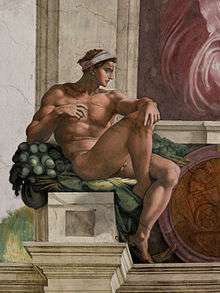
Ignudi
(For images, see gallery)
The Ignudi[nb 16] are the 20 athletic, nude males that Michelangelo painted as supporting figures at each corner of the five smaller narrative scenes that run along the centre of the ceiling. The figures hold or are draped with or lean on a variety of items which include pink ribbons, green bolsters and enormous garlands of acorns.[nb 8]
The Ignudi, although all seated, are less physically constrained than the Ancestors of Christ. While the pairs of the monochrome male and female figures above the spandrels are mirrors of each other, these Ignudi are all different. In the earliest paintings, they are paired, their poses being similar but with variation. These variations become greater with each pair until the postures of the final four bear no relation to each other whatsoever.
The meaning of these figures has never been clear. They are certainly in keeping with the Humanist acceptance of the classical Greek view that "the man is the measure of all things".[56] But Michelangelo knew the Bible well.[11] He would have been well aware of the fact that although seraphim and cherubim are described as being winged creatures. They are described as looking like men.[Src 16] When Michelangelo later painted the altar wall of the chapel, he included a great number of angels, particularly in the lunettes which are decorated with scenes of angels carrying the symbols of the Passion. Other angels are employed sounding the trumpets which call forth the dead, displaying books in which the names of the saved and the damned are written and casting sinners down to Hell. In all, the Last Judgement contains more than forty angels, all closely resembling the Ignudi. It is reasonable to conclude that the Ignudi represent angels.[11][57] If the Ignudi are indeed angels, they are the ever-present attendants and messengers of God, impassively watching and waiting on the fate of Humankind.
Their painting demonstrates, more than any other figures on the ceiling, Michelangelo's mastery of anatomy and foreshortening and his enormous powers of invention.[nb 17] In their reflection of classical antiquity they resonate with Pope Julius' aspirations to lead Italy towards a new 'age of gold'; at the same time, they staked Michelangelo's claim to greatness.[58] However, a number of critics were angered by their presence and nudity, including Pope Adrian VI who wanted the ceiling stripped.
Stylistic analysis and artistic legacy
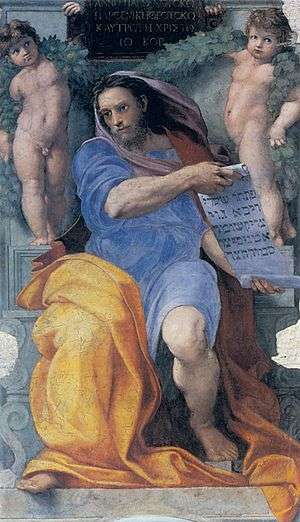
Michelangelo was the artistic heir to the great 15th-century sculptors and painters of Florence. He learnt his trade first under the direction of a masterly fresco painter, Domenico Ghirlandaio, known for two great fresco cycles in the Sassetti Chapel and Tornabuoni Chapel, and for his contribution to the cycle of paintings on the walls of the Sistine Chapel. As a student Michelangelo studied and drew from the works of the two most renowned Florentine fresco painters of the early Renaissance, Giotto and Masaccio.[59] Masaccio's figures of Adam and Eve being expelled from the Garden of Eden had a profound effect on the depiction of the nude in general, and in particular on the use of the nude figure to convey human emotion.[Fig 31] Helen Gardner says that in the hands of Michelangelo "the body is simply the manifestation of the soul, or of a state of mind and character".[59]
Michelangelo was also almost certainly influenced by the paintings of Luca Signorelli[59] whose paintings, particularly the Death and Resurrection Cycle in Orvieto Cathedral contain a great number of nudes and inventive figurative compositions.[Fig 32] In Bologna, Michelangelo saw the relief sculptures of Jacopo della Quercia around the doors of the cathedral. In Michelangelo's depiction of the Creation of Eve the whole composition, the form of the figures and the relatively conservative concept of the relationship between Eve and her Creator adheres closely to Jacopo's design.[13] Other panels on the ceiling, most particularly the iconic Creation of Adam show "... unprecedented invention".[13]
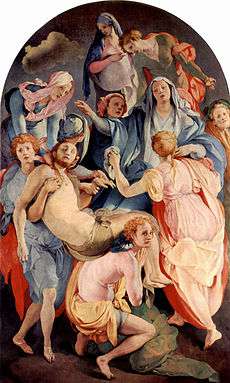
The ceiling of the Sistine Chapel was to have a profound effect upon other artists, even before it was completed. Vasari, in his Life of Raphael, tells us that Bramante, who had the keys to the chapel, let Raphael in to examine the paintings in Michelangelo's absence. On seeing Michelangelo's prophets, Raphael went back to the picture of the Prophet Isaiah that he was painting on a column in the Church of Sant'Agostino and, according to Vasari, although it was finished, he scraped it off the wall and repainted it in a much more powerful manner, in imitation of Michelangelo.[9] John O'Malley points out that even earlier than the Isaiah is Raphael's inclusion of the figure of Heraclitus in the School of Athens, a brooding figure similar to Michelangelo's Jeremiah, but with the countenace of Michelangelo himself, and leaning on a block of marble.[60][Fig 33]
There was hardly a design element on the ceiling that was not subsequently imitated: the fictive architecture, the muscular anatomy, the foreshortening, the dynamic motion, the luminous colouration, the haunting expressions of the figures in the lunettes, the abundance of putti. Gabriele Bartz and Eberhard König have said of the Ignudi, "There is no image that has had a more lasting effect on following generations than this. Henceforth similar figures disported themselves in innumerable decorative works, be they painted, formed in stucco or even sculpted."[61]
Within Michelangelo's own work, the chapel ceiling led to the later and more Mannerist painting of the Last Judgement in which the crowded compositions gave full rein to his inventiveness in painting contorted and foreshortened figures expressing despair or jubilation. Among the artists in whose work can be seen the direct influence of Michelangelo are Pontormo, Andrea del Sarto, Correggio, Tintoretto, Annibale Carracci, Paolo Veronese and El Greco.
In January 2007, it was claimed that as many as 10,000 visitors passed through the Vatican Museums in a day and that the ceiling of the Sistine Chapel is the biggest attraction. The Vatican, anxious at the possibility that the newly restored frescoes will suffer damage, announced plans to reduce visiting hours and raise the price in an attempt to discourage visitors.[62]
Five hundred years earlier Vasari had said "The whole world came running when the vault was revealed, and the sight of it was enough to reduce them to stunned silence."[9]
Restoration
The frescoes of the Sistine Chapel were restored between June 1980 and December 1999, with preliminary tests taking place in 1979.
The first stage of restoration, the work upon Michelangelo's lunettes, was achieved in October 1984. The work then proceeded on the ceiling, completed December 1989 and from there to the Last Judgement. The restoration was unveiled by Pope John Paul II on 8 April 1994. The restoration team comprised Gianluigi Colalucci, Maurizio Rossi, Piergiorgio Bonetti, Bruno Baratti and others. The final stage was the restoration of the wall frescoes by Botticelli, Domenico Ghirlandaio, Perugino and others, This was unveiled on 11 December 1999.[63]
The colours, which now appear so fresh and spring-like with pale pink, apple green, vivid yellow and sky blue against a background of warm pearly grey, were so discoloured by candle smoke as to make the pictures seem almost monochrome. The restoration has removed the filter of grime to reveal the colours again.[63] However, the restoration was met with both praise and criticism. Critics assert that much original work by Michelangelo – in particular pentimenti, highlights and shadows, and other detailing painted a secco – was lost in the removal of various accretions.[64]
Quotations
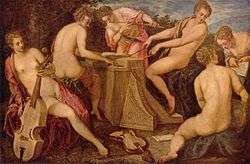
Vasari
- "The work has proved a veritable beacon to our art, of inestimable benefit to all painters, restoring light to a world that for centuries had been plunged into darkness. Indeed, painters no longer need to seek for new inventions, novel attitudes, clothed figures, fresh ways of expression, different arrangements, or sublime subjects, for this work contains every perfection possible under those headings."[9]
Johann Wolfgang Goethe
- "Without having seen the Sistine Chapel one can form no appreciable idea of what one man is capable of achieving."
Waldemar Januszczak The art critic and television producer Waldemar Januszczak wrote that when the Sistine Chapel ceiling was recently cleaned, he "was able to persuade the man at the Vatican who was in charge of Japanese TV access to let me climb the scaffold while the cleaning was in progress."
- "I sneaked up there a few times. And under the bright, unforgiving lights of television, I was able to encounter the real Michelangelo. I was so close to him I could see the bristles from his brushes caught in the paint; and the mucky thumbprints he'd left along his margins. The first thing that impressed me was his speed. Michelangelo worked at Schumacher pace. Adam's famous little penis was captured with a single brushstroke: a flick of the wrist, and the first man had his manhood.[nb 18] I also enjoyed his sense of humour, which, from close up, turned out to be refreshingly puerile. If you look closely at the angels who attend the scary prophetess on the Sistine ceiling known as the Cumaean Sibyl, you will see that one of them has stuck his thumb between his fingers in that mysteriously obscene gesture that visiting fans are still treated to today at Italian football matches."[65]
Gabriele Bartz and Eberhard König
- "In a world where all experience was based in the glorious lost past of Antiquity, he made a new beginning. Michelangelo, more even than Raphael or Leonardo, embodies a standard of artistic genius which reveals a radically changed image of human beings and their potential ..."[13]
Pope John Paul II
- "It seems that Michelangelo, in his own way, allowed himself to be guided by the evocative words of the Book of Genesis which, as regards the creation of the human being, male and female, reveals: 'The man and his wife were both naked, yet they felt no shame'. The Sistine Chapel is precisely – if one may say so – the sanctuary of the theology of the human body. In witnessing to the beauty of man created by God as male and female, it also expresses in a certain way, the hope of a world transfigured, the world inaugurated by the Risen Christ."[66]
In popular culture
- In many works, the painting of God and Adam are parodied. See The Creation of Adam for more.
- In the film 2012, the entire College of Cardinals are seen praying silently under the ceiling. The ceiling then starts to crack, commencing at the point where God's and Adam's fingers nearly touch, dividing the two.
- In Life After People: The Series, the Sistine chapel is seen falling after 500 years.
- Playwright Neil Simon's quote about the Sistine floor-"If no one took any risks, Michaelangelo would have painted the Sistine floor."
- The 1965 film The Agony and the Ecstasy features the story of Michelangelo and his travails in painting the Sistine Chapel. He is portrayed in the film by Charlton Heston.
- In the 2009 film Angels & Demons and also in the 2000 book on which the film is based, the chapel is featured throughout the story.
- In the video game Assassin's Creed 2, the final mission in the game climaxes with the Assassin Ezio Auditore climbing along the Sistine Chapel ceiling to assassinate the Pope. Notably, while the Chapel ceiling is depicted as being completed in-game, the final mission takes place several years before the Chapel's ceiling was painted.
See also
Notes
- ↑ e.g., in the Creation of Adam
- ↑ Vasari says that Michelangelo, even as a boy, had "the ability and judgement, fire and boldness to improve upon the work of his master"
- ↑ This was epitomised by Giovanni Pico della Mirandola's Oration on the Dignity of Man. O'Malley, p.122.
- ↑ Vasari interpreted the Sacrifice of Noah as that of Cain and Abel
- ↑ Anthony Bertram (1970) discusses this as a hidden layer in the meanings of these works and notes that "The principal opposed forces in this conflict were his passionate admiration for classical beauty and his profound, almost mystical Catholicism, his homosexuality, and his horror of carnal sin combined with a lofty Platonic concept of love."
- ↑ These are not marked on the drawn plan but are clearly visible in the photographs.
- ↑ e.g. "egg and dart", "bead and reel".
- 1 2 Sixtus IV, and Julius II were both of the Della Rovere family. "Rovere" in Italian means "Oak", Quercus robur.
- ↑ The scallop shell (and pearl) is a symbol of the doctrine of divine conception in renaissance and baroque art.
- ↑ The technique that Michelangelo has employed is unusual in fresco, and may be original in its employment on this scale, but is not unique. He has utilised the same technique that was employed for decorating shields used in pageants and is similar to that used when drawing in metal point and white chalk on a coloured ground. The ground colour (in this case red ochre streaked with black) makes the background and all the mid tones in the composition. The shadowed edges are then painted or rather, drawn with a brush and the shadows drawn in a highly linear manner that defines the contours of the forms. On coloured paper, the highlights and brightly lit contours would usually be drawn with white chalk or finely painted in white paint. But in this case, gold leaf entirely replaces the white and has been applied exactly as if it had been drawn on, using the same method of defining contour as the black lines. A number of shields decorated by this technique are displayed in the Victoria and Albert Museum, London.
- ↑ Which is usually interpreted as a whale.
- ↑ The lunettes specifically follow the genealogy according to Matthew, not the somewhat longer genealogy according to Luke. Over large stretches, the two genealogies differ, and choosing Matthew's over Luke's has interesting theological implications (see Genealogy of Jesus).
- ↑ In Renaissance art it was usual to depict Joseph as an old man to whom Mary had been given in marriage. cf. the Cherry Tree Carol "Joseph was an old man, and a bad old man was he, when he wedded Mary in the land of Galilee."(English 15th century). Traditionally, he is often dressed in a blue garment with a yellow cloak, e.g. Fra Angelico's Adoration.
- ↑ This is apparent from the giornata, the area plastered and painted in a single day.
- ↑ "Halination" is the effect of bright areas blurring over less bright ones.
- ↑ singular: Ignudo; from the Italian adjective nudo, meaning "naked"
- ↑ see Vasari's comments under "Quotations".
- ↑ This is pure fantasy on behalf of the writer. It is true, however, that a single brushstroke has been used for the dark shadow that defines the underside of Adam's penis.
References
- ↑ Shearman 1986, pp. 22–36
- 1 2 Shearman 1986b, pp. 38–87
- 1 2 3 O'Malley 1986, pp. 92–148
- ↑ Partridge 1996, p. 15
- 1 2 3 4 5 6 7 Goldscheider 1953.
- ↑ Shearman 1986b, pp. 45–47
- ↑ Partridge, 1996, p. 10
- ↑ Partridge, 1996, p. 11
- 1 2 3 4 5 6 7 8 9 10 11 12 Vasari 1568.
- ↑ 'Humanists and Reformers: A History of the Renaissance and Reformation' by Bard Thompson, p. 267
- 1 2 3 4 O'Malley 1986, p. 104.
- ↑ Partridge 1996, p. 13.
- 1 2 3 4 5 6 Bartz 1998.
- ↑ Graham-Dixon 2008, p. 181 ff.
- 1 2 3 4 5 6 Mancinelli 1986, pp. 220–259
- 1 2 3 Condivi 1553.
- ↑ Goldscheider 1951.
- 1 2 3 4 Gardner, Art Through the Ages, pp. 469–472
- ↑ Bartz and König, p.55
- ↑ Hurst 1986
- ↑ Buonarotti (trans. Symonds 1878)
- ↑ Blech, Benjamin. The Sistine Secrets: Michelangelo's Forbidden Messages in the Heart of the Vatican, HarperOne, (2009)
- ↑ wrote Foreword to Blech's book, Enrico bruschini website
- ↑ O'Malley, p.112
- ↑ Gardner, p.466–467
- ↑ Aston 1979, pp. 111–112
- ↑ O'Malley, pp. 102–110
- ↑ O'Malley, p. 105
- 1 2 Shearman 1986, pp. 29–30
- ↑ O'Malley, p.100
- ↑ Partridge 1996, p. 9
- ↑ O'Malley, p.95
- ↑ O'Malley, pp. 104–105, 160–161
- 1 2 3 Paoletti and Radke p.402–403
- 1 2 See Poor Man's Bible
- ↑ Bartz and König, p.54
- ↑ Gardner, p. 467
- ↑ Charles de Tolnay, translated by Nan Buranelli, The Art and Thought of Michelangelo, Pantheon, (1964)
- ↑ Renaissance at the V&A. Accessed 19-05-2009
- ↑ Shearman 1986.
- 1 2 O'Malley, pp. 106–107
- ↑ O'Malley, pp. 120–22
- 1 2 Jaritz, p. 16
- 1 2 O'Malley, p.116
- ↑ O'Malley, pp. 107–117
- ↑ Paoletti and Radke, p. 407
- 1 2 3 4 O'Malley, picture captions, pp. 162–169
- ↑ Bartz and König, p.56
- ↑ Mancinelli, p. 238
- 1 2 O'Malley, p.170–174
- ↑ Graham-Dixon 2008, p. 137
- ↑ Graham-Dixon 2008, p. 138.
- ↑ Graham-Dixon 2008, p. 141
- ↑ Bartz and König, p. 44
- ↑ Mancinelli, pp.234–236
- ↑ Protagoras of Abdera, (c. 480–410 B.C.).
- ↑ Hersey 1993.
- ↑ Graham-Dixon 2008, p. 136
- 1 2 3 Gardner 1970.
- ↑ O'Malley, pp.156–158
- ↑ Bartz and König, pages 45 and 52
- ↑ Richard Owen, "Vatican puts a squeeze on visitors", Timesonline, January 6, 2007.
- 1 2 Pietrangeli 1994
- ↑ Beck 1995.
- ↑ Januszczak, Waldemar. "The Michelangelo Code". Sunday Times (London), March 5, 2006.
- ↑ John Paul II 1994
Reference images
- ↑ First Day of Creation, in context with shields and Ignudi (restored)
- ↑ Dividing Water and Heavens, in context with shields and Ignudi (restored)
- ↑ Creation of the Earth and the celestial bodies, (restored)
- ↑ God creating Eve from the side of the sleeping Adam, in context with shields and Ignudi (before restoration)
- ↑ Adam and Eve: temptation and banishment (restored)
- ↑ The Sacrifice of Noah (restored)
- ↑ The Great Flood (before restoration)
- ↑ Noah's drunkenness in context, with shields and Ignudi (before restoration)
- ↑ The "Uriah" shield
- ↑ The incomplete medalion on the left-hand side of the "Separation of the Waters" panel
- 1 2 The prophet Jonah (restored)
- ↑ The prophet Jeremiah (restored)
- ↑ The Persian Sibyl (restored)
- ↑ The prophet Ezekiel (restored)
- 1 2 The Erithraean Sibyl (before restoration)
- ↑ The prophet Joel (before restoration)
- ↑ The prophet Zechariah (before restoration)
- ↑ The Delphic Sibyl (restored)
- 1 2 The prophet Isaiah (restored)
- ↑ The Cumean Sibyl (restored)
- ↑ The prophet Daniel (before restoration)
- ↑ The Libyan Sibyl (restored)
- ↑ The Brazen Serpent (Before restoration)
- ↑ The crucifixion of Haman (Before restoration)
- ↑ David slaying Goliath (Before restoration)
- ↑ Judith carrying the head of Holofernes (Before restoration)
- ↑ The destroyed lunettes: Abraham / Isaac / Jacob / Judah and Pharez / Hezron / Ram, engravings by William Young Ottley.
- ↑ Woman cutting garment The "Salmon Spandrel" (restored)
- ↑ The Blessed Virgin Mary(?) looking from a spandrel before and after restoration.
- ↑ Eleazar and Mathan lunette (before restoration)
- ↑ Masaccio: The Expulsion from the Garden of Eden fresco, 208 cm × 88 cm (82 in × 35 in) Cappella Brancacci, Santa Maria del Carmine, Florence
- ↑ Luca Signorelli: Resurrection of the Flesh (1499–1502) Chapel of San Brizio, Duomo, Orvieto
- ↑ Raphael (ca. 1509) Heraclitus Detail from the School of Athens, a portrait of Michelangelo
Biblical sources
- ↑ Genesis, chapter 1
- ↑ Genesis, chapters 1–3
- ↑ Genesis, chapters 6–9
- ↑ Second Book of Kings, chapter 2:11–13
- ↑ Joel, chapter 2, verse 28.
- ↑ Zechariah, chapter 9, verse 9; Matthew, chapter 21, verses 4–5
- ↑ The Book of Jonah
- ↑ Gospel of Matthew 12:39–40.
- ↑ Book of Micah, chapter 5, verse 2; Gospel of Matthew, chapter 2, verse 6.
- ↑ Gospel of Luke
- ↑ Gospel of Matthew
- ↑ The Book of Numbers, chapter 21:4–9
- ↑ The Book of Esther
- ↑ First Book of Samuel, chapter 2:18
- ↑ Isaiah 11:1
- ↑ e.g. Genesis, chapter 18.
Bibliography
- Aston, Margaret (1979) "The fifteenth century: the prospect of Europe". W.W. Norton, New York. ISBN 0-393-95097-2
- Bartz, Gabriele; König, Eberhard (1998). Michelangelo, Könemann. ISBN 3-8290-0253-X
- Beck, James; Daley, Michael (1995). Art Restoration, the Culture, the Business and the Scandal, W.W. Norton. ISBN 0-393-31297-6
- Bertram, Anthony (1970). Michelangelo, 1970, Studio Vista. ISBN B00071KTVA
- Buonarotti, Michelangelo; Campanella, Tommaso (1878). The Sonnets of Michael Angelo Buonarotti and Tommaso Campanella Now For the First Time Translated into Rhymed English. Project Gutenberg EBooks. 10314. Translated by John Addington Symonds. Retrieved 2 June 2009.
- Condivi, Ascanio (1553). Life of Michelangelo
- Efetov, Konstantin (2006), A shocking secret of the Sistine Chapel, Simferopol: CSMU Press, ISBN 966-2969-17-9
- Freidenthal, Richard (1963). Letters of the Great Artists, 1963, Thames and Hudson
- Gardner, Helen (1970) Art through the Ages, Harcourt, Brace and World. ISBN 978-0-15-508315-8
- Giacometti, Massimo (1984). The Sistine Chapel, a collection of essays on aspects of the chapel, its decoration and the restoration of Michelangelo's frescoes, by Carlo Pietrangeli, André Chastel, John Shearman, John O'Malley S.J., Pierluigi de Vecchi, Michael Hirst, Fabrizio Mancinelli, Gianluigi Colallucci, and Franco Bernabei. 1984, Harmony Books. ISBN 0-517-56274-X
- Graham-Dixon, Andrew (2008). Michelangelo and the Sistine Chapel. London: Weidenfeld & Nicholson. ISBN 978-0-297-85365-7.
- Goldscheider, Ludwig (1951). Michelangelo: Drawings, Phaidon.
- Goldscheider, Ludwig (1953). Michelangelo: Paintings, Sculpture, Architecture, Phaidon.
- Hale, J.R. (1979). Renaissance Europe, 1480–1520, Fontana/Collins. ISBN 0-00-632435-5
- Hersey, George L. (1993) High Renaissance Art in St. Peter's and the Vatican, University of Chicago Press. ISBN 0-226-32782-5
- Hirst, Michael (1986). in The Sistine Chapel, ed. Massimo Giacometti
- The Holy Bible, various authors, King James version.
- Jaritz, Gerhard (2012). Ritual, Images, and Daily Life. The Medieval Perspective. Münster: LIT Verlag. p. 16. ISBN 3-643-90113-5.
- John Paul II (1994). "Homily of His Holiness John Paul II, 8 April 1994". Homily preached at the mass of to celebrate the unveiling of the restorations of Michelangelo's frescoes in the Sistine Chapel. Vatican Publishing House. Retrieved 2009-06-04.
- Mancinelli, Fabrizio (1986). in The Sistine Chapel, ed. Massimo Giacometti
- O'Malley, John (1986). The Theology behind Michelangelo's Ceiling in The Sistine Chapel, ed. Massimo Giacometti.
- Paoletti, John T.; Radke, Gary M. (2005). Art in Renaissance Italy, Laurence King. ISBN 1-85669-439-9
- Partridge, Loren (1996). Michelangelo. The Sistine Chapel Ceiling, Rome. New York: George Braziller. ISBN 0-8076-1315-0.
- Pietrangeli, Hirst and Colalucci, eds. (1994). The Sistine Chapel: A Glorious Restoration. Italy, Harry N Abrams
- Shearman, John (1986) The Chapel of Sixtus IV in The Sistine Chapel, ed. Massimo Giacometti.
- Shearman, John (1986b) The Fresco Decoration of Sixtus IV in The Sistine Chapel, ed. Massimo Giacometti.
- Vasari, Giorgio (1568). Lives of the Artists, 'Michelangelo'. Trans. George Bull, 1965, Penguin Classics. ISBN 0-14-044164-6
- Vecchi, Pierluigi de, ed. (1994). The Sistine Chapel: A Glorious Restoration, Abrams. ISBN 0-8109-3840-5
External links
| Wikimedia Commons has media related to Sistine Chapel ceiling. |
- Vatican Museum
- Visual/Interactive Tour of the Sistine Chapel Ceiling and upper walls, with identifications and detail images
- Zoomable Panoramic View of the Sistine Chapel Ceiling (HTML5)
- Michelangelo's Ceiling of the Sistine Chapel, Smarthistory video (22:03)
- Models of wax and clay used by Michelangelo in making his sculpture and paintings
- The Sistine Ceiling and the Holy Spirit


